Company/August 23, 2023
From an App Built in 2 Days to 1,000,000 Signups 7 Months Later

Alfred
Co-founder
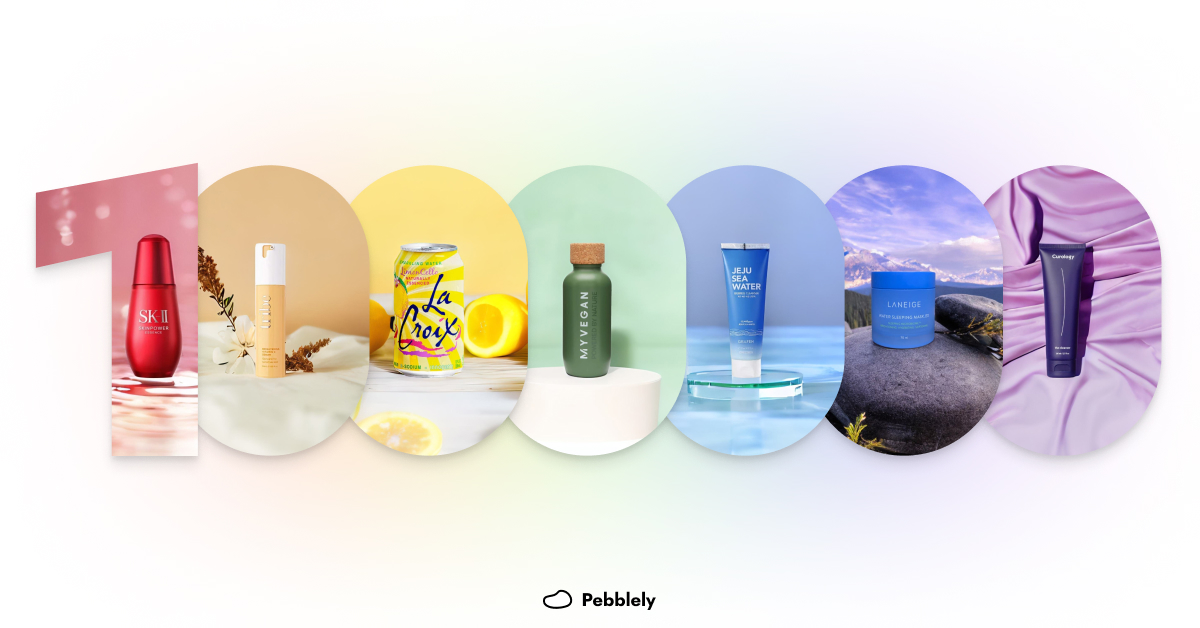
This is our first project to ever hit 1,000,000 signups—and in just 7 months. We want to share the journey so far and some lessons we picked up along the way. Grab a cup of coffee and enjoy!
We recently crossed 1,000,000 signups, so I thought it would be fun to reflect on our journey, see how far we have come, and share some lessons we learned. I hope this will be useful to you too!
Some quick stats first:
- 7 months since launch
- 1,060,000+ signups
- Paying customers in 100+ countries
- 3.5 team members (2 cofounders, 1 software engineer, 1 part-time AI researcher)
AI product photography
We launched Pebblely, our AI product photography tool, on 4 January 2023.
By launch, I meant I was sitting on a public bench and casually pressing the Post button on LinkedIn because we didn’t think much of the launch. No PR campaigns, no ads, no fancy parties.
That was less than a year ago. But so much has changed since.
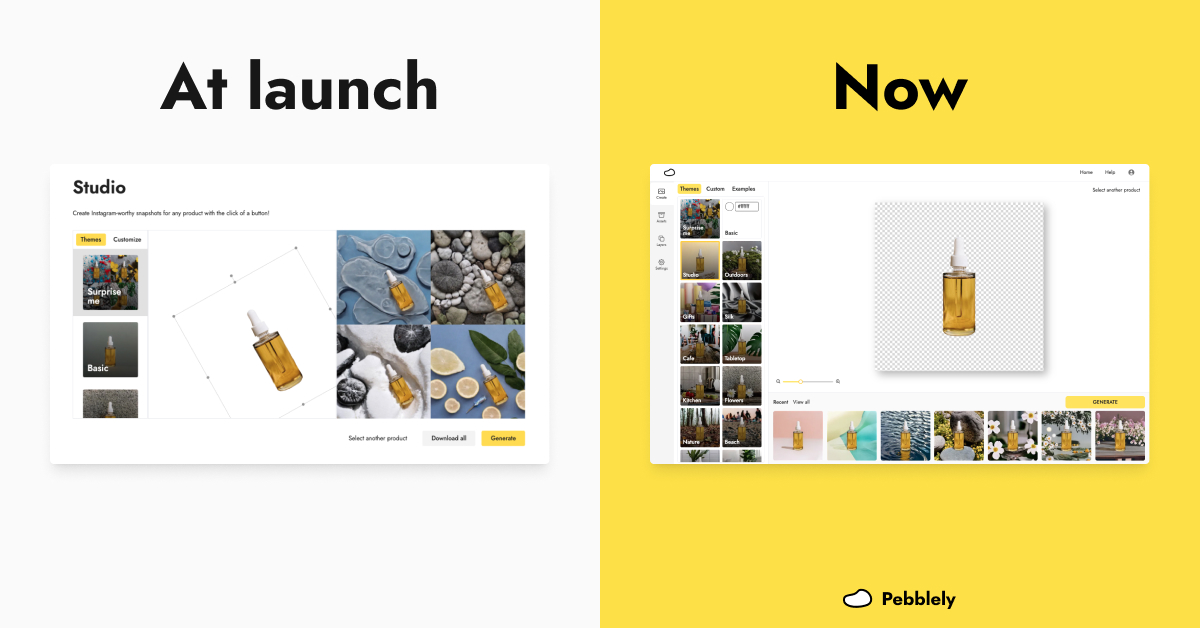
When we first launched Pebblely…
- You could only generate images at 512X512 pixels (tiny!)
- You could only generate square images.
- You could only generate images with a single product.
- Each image takes 10 seconds to generate and 60 seconds to upscale.
Honestly, we weren’t even sure people would want to use something like this (more on this at the end). But even then, Pebblely offered something most AI image tools couldn’t do then:
Placing your product in AI-generated images.
You can even position, resize, and rotate your product on the canvas before generating images. On the other hand, most AI image tools were stuck at taking in text and spitting out images. Even popular tools like Midjourney, which can take in reference images, will warp your product, which is unacceptable for commerce.
Just seven months later…
- You can generate images up to 2048X2048 pixels.
- You can generate images at any aspect ratio.
- You can generate images with multiple products.
- Each image takes only 3-5 seconds to generate and 5-10 seconds to upscale.
But there’s so much more:
- You can extend generated images (e.g. from square to 9:16) to use them as social media images, hero images, email banners, and more.
- You can use reference images to have more control over the colors and get better results.
- You can edit generated images to fix issues, tweak the background, or resize your product.
- When you generate a background you like, you can also reuse the background for different products.
We also added a better background remover, more free themes, keyboard shortcuts, a gallery of examples, and more.
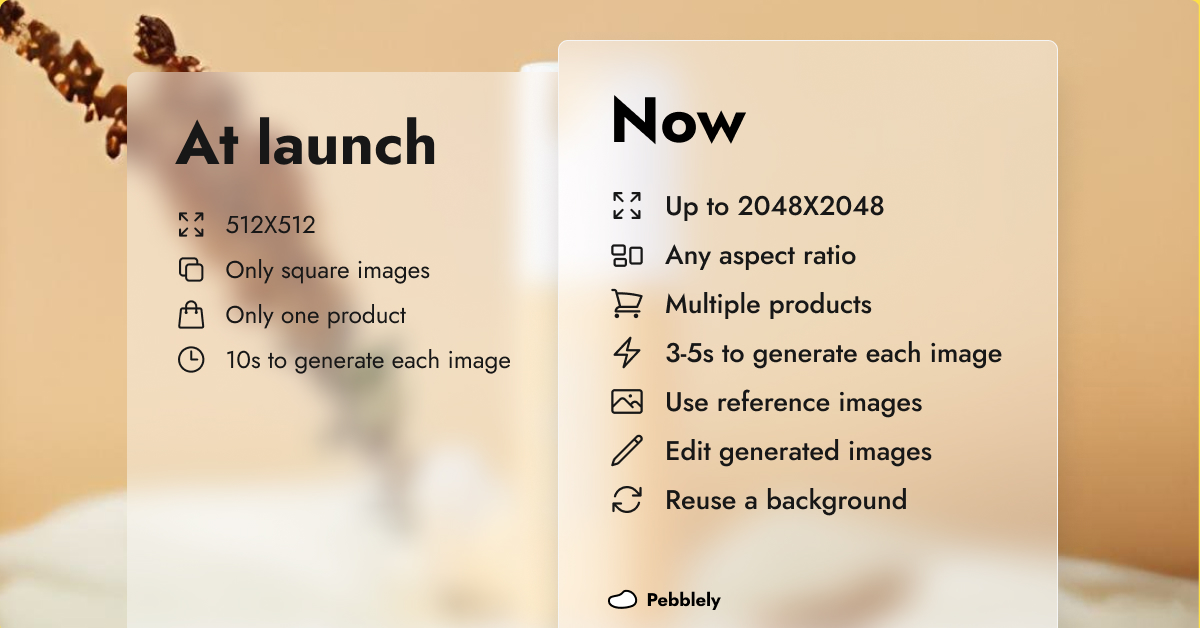
The Pebblely community
The improvements mentioned above were added thanks to the feedback from our customers. I want to quickly highlight a few customers; most of whom supported us from the start:
- The ShoeCo uses Pebblely-generated images on Facebook and Instagram to sell their stylish yet comfortable shoes.
- Enzo Chehab uses Pebblely-generated images to get higher engagement on their Instagram ads.
- Homes of Rajasthan generates product photos of their furniture and save on expensive photo shoots.
- Duckshop, one of the largest rubber duck shops, uses Pebblely to generate matching backgrounds for their 2,000+ ducks.
- The Brownie Bar mixes Pebblely-generated images, well-designed graphics, and actual photos to sell their delicious brownies on Instagram.
Go check out their stores and support them!

I also want to give a shoutout to those who have voluntarily shared about Pebblely. And often in very creative ways. For example, Manu Velez signed on a product, took a photo, and use it in Pebblely to show that the generated images have the actual product.
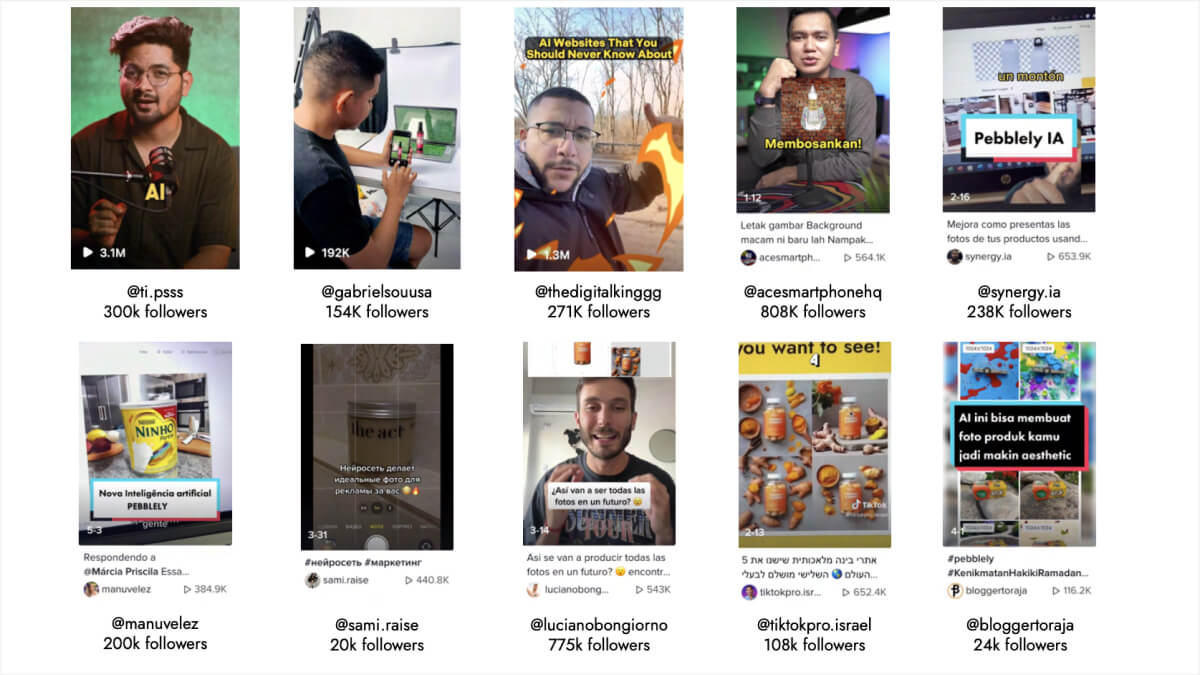
Swee Kiat and I started Pebblely with only our savings from our previous jobs and no external funding. We had even spent seven months last year on another idea, which we eventually shut down. Unlike venture-backed companies, we cannot splurge on advertisements and sponsorships. So all these recommendations and support have helped us a lot.
It is also amazing to see that videos of Pebblely often become the most viewed video for many creators! I hope, in a way, we also helped to grow their reach and following.
(If you want to review Pebblely, we are happy to upgrade your account and give you some credits to test. Let me know.)
3 startup lessons we have learned
As first-time founders, we are still figuring many things out. But we have picked up several valuable lessons that we will continue to apply. If you are working on a startup, these could be helpful to you too.
1. Find fast moving water
A lot of our success so far has been due to this fast moving water called AI. We were at the right place at the right time. ChatGPT started taking off, and many people went from not knowing what AI is to raving about AI. Thanks to this trend, we have been featured in countless posts about the top 10 AI tools to use. People have also been more willing to spend money on AI tools. Essentially, we were lucky.
Coincidentally, Swee Kiat has been researching AI image generation since his Computer Science MS degree at Stanford and had even toyed with some related ideas when DALL-E first came out. When he noticed the huge improvement in AI image generation last year, he wondered, “Could it have any commercial use case, besides creating art?” Well, I used to run Open Atlas, an ecommerce store, where I spent Saturdays taking product photos at various places.
To be clear, it was not like we had this eureka moment and everything was sorted. Ultimately, we still had to build a product people want. Fortunately, Swee Kiat could build really fast because he is already familiar with the technologies, and I could market well because I know the target audience. This helped us get off to a good start.

2. Launch ASAP and iterate quickly
We already had the image generation technology in December. But we didn’t build the user interface because we were not sure people wanted something like this. I cold-emailed many people to sell them our AI product photography service but no one was interested. Swee Kiat realized it might be easier to just build a basic user interface (which he did in two days) and let people try it themselves. That's when we launched Pebblely.
As builders, we often want to keep building until we think the product is good enough before letting people use it. But it's hard to build something people want without getting their feedback.
Here are another two interesting examples from the past few months:
First example: When we launched, we didn't optimize our servers to handle huge volumes. One, our top priority was to learn whether Pebblely can solve a core problem for customers. If it couldn't, optimizing our servers prematurely is just a waste of time. It feels necessary but it isn't. Two, it's very unlikely for any new product to go viral immediately. So we knew we could work on scalability later. As luck would have it, we had sudden huge spikes in signups (more than 10,000 per day at one point) and our servers crashed several times. When customers complained that they couldn't use the app, we realized Pebblely is solving a core problem for them. We have since scaled our servers to handle hundreds of thousands of images every day.
Second example: We didn't know whether 512X512 images are big enough for merchants to use. After we launched, we realized most merchants first cared about whether the generated images are realistic enough. Many merchants were actually fine with the size. But they got used to the photorealism quickly and eventually complained about the size. So we improved the quality such that images were generated at 1024X1024 by default and can be upscaled further to 2048X2048. Then they asked if they could generate non-square images. So we added the ability to change the canvas size and expand generated images. Then they complained about images with weird objects or wrong proportions. So we made it possible to edit the generated images to fix these issues.
In hindsight, these improvements might seem obvious and we could have prevented the complaints. But in reality, at those points in time, we had no clue. We had to get our customers' feedback to improve Pebblely through an iterative process.
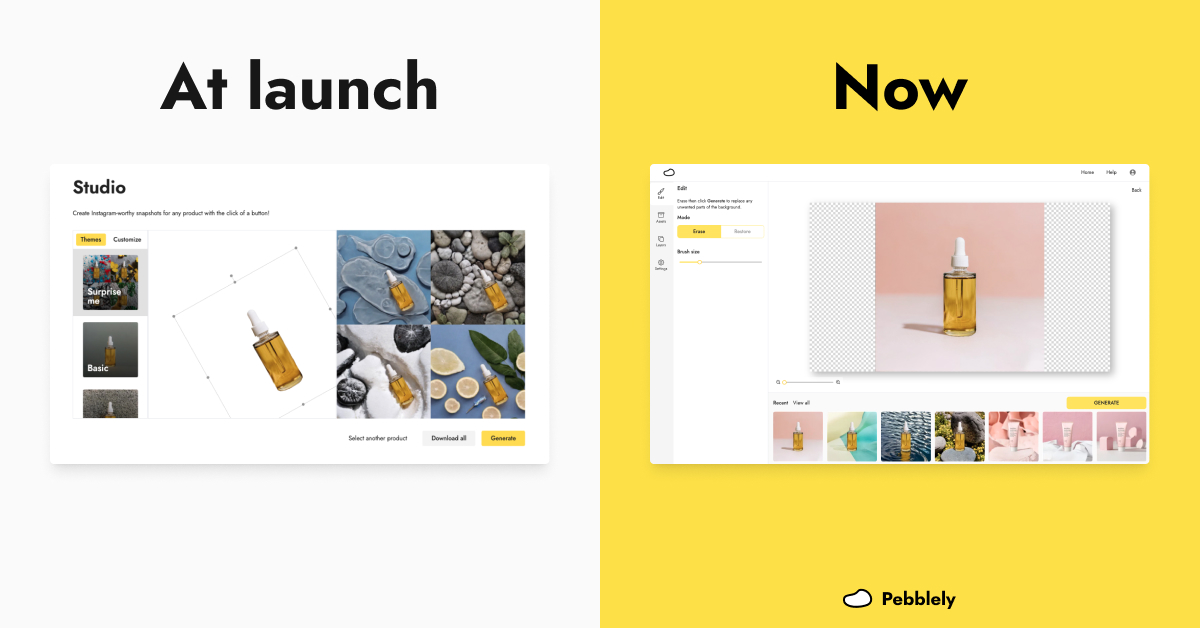
3. Talk to customers and observe
This is the most obvious thing to do yet most people would choose to avoid it as much as possible.
We talk to our customers every day. Whenever someone downloads more than 100 images, we reach out to them for a chat. Whenever someone cancels their subscription, we email them to learn more. In our onboarding emails, we share our Calendly link and ask customers to schedule calls with us. (Fun fact: According to our Calendly, we have had 124 video chats so far!)
We picked up many product and marketing insights from our customer chats. For example, our viral 1.4m-views TikTok video was inspired by one of the chats. Chris Bergin, a senior paid media executive at Launch, shared with me a common problem agencies face: Clients expect them to run multiple ads with a single photo of their product. With Pebblely, you can actually turn a single photo into multiple assets. So I turn this insight into a video on a Saturday evening and posted it on TikTok. Three days later, it exploded.
Here’s another story: I noticed people who were sharing about Pebblely on social media were mostly using our web app on their mobile phones (example). The problem is our web app wasn’t that mobile friendly. We quickly fixed it and told the community about it. I believe this has encouraged more people to use and share about Pebblely.

So, what’s next?
AI image generation technologies are improving very quickly, and we hope to leverage them as new ones come along. You can expect the image quality to get even better soon. (Note: We do not use user-generated images for any training!)
Besides that, there are a few projects we are excited to work on next, such as:
- Generating hands
- Generating human models
- Organizing generated images automatically
We have already been researching and experimenting with some of these and hope to make them available in the coming months. As always, if you have any feedback or other requests, feel free to let us know at hello@pebblely.com!
Thank you again for your support on this journey. Here’s to the next million! 🥂
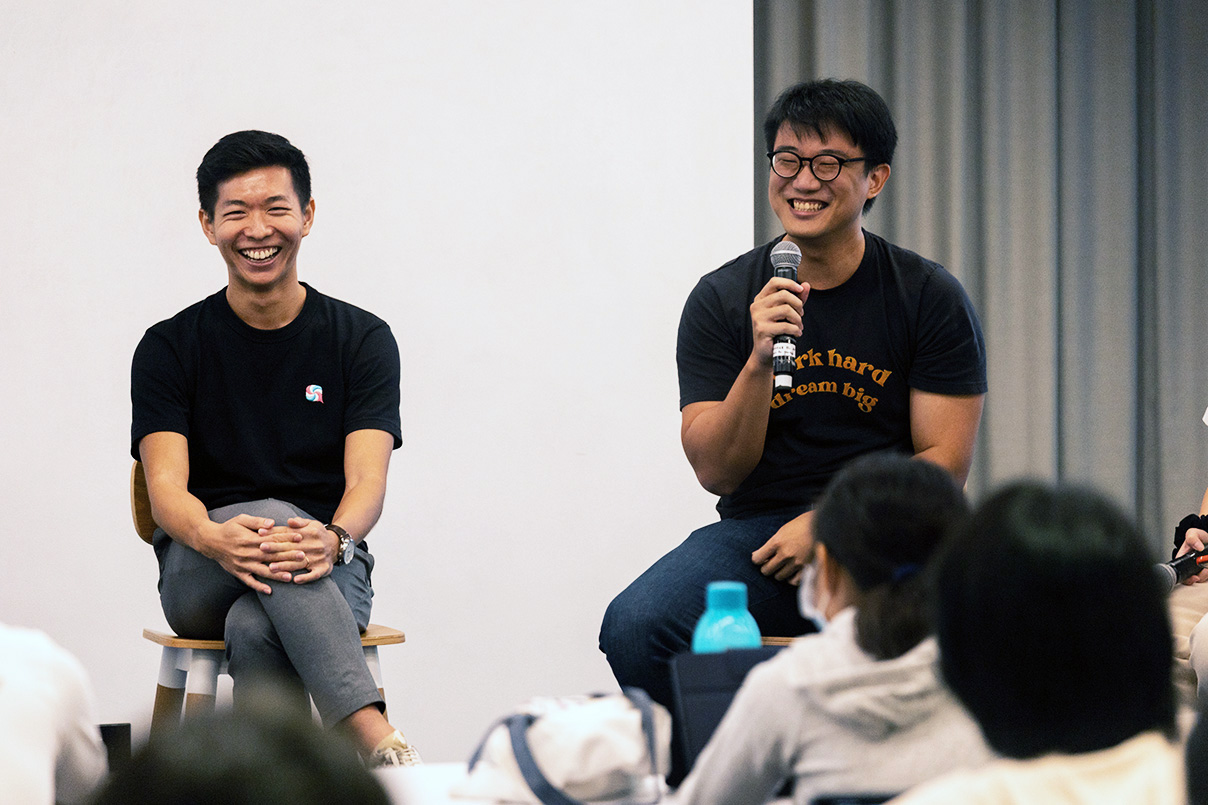
P.S. After seeing how Pebblely has helped countless merchants with AI image generation, we are inspired to help even more people leverage AI image generation. We are also working on a second product, Vispunk, an AI image generator for people who want more control over the image generation. If you are interested, join our beta.